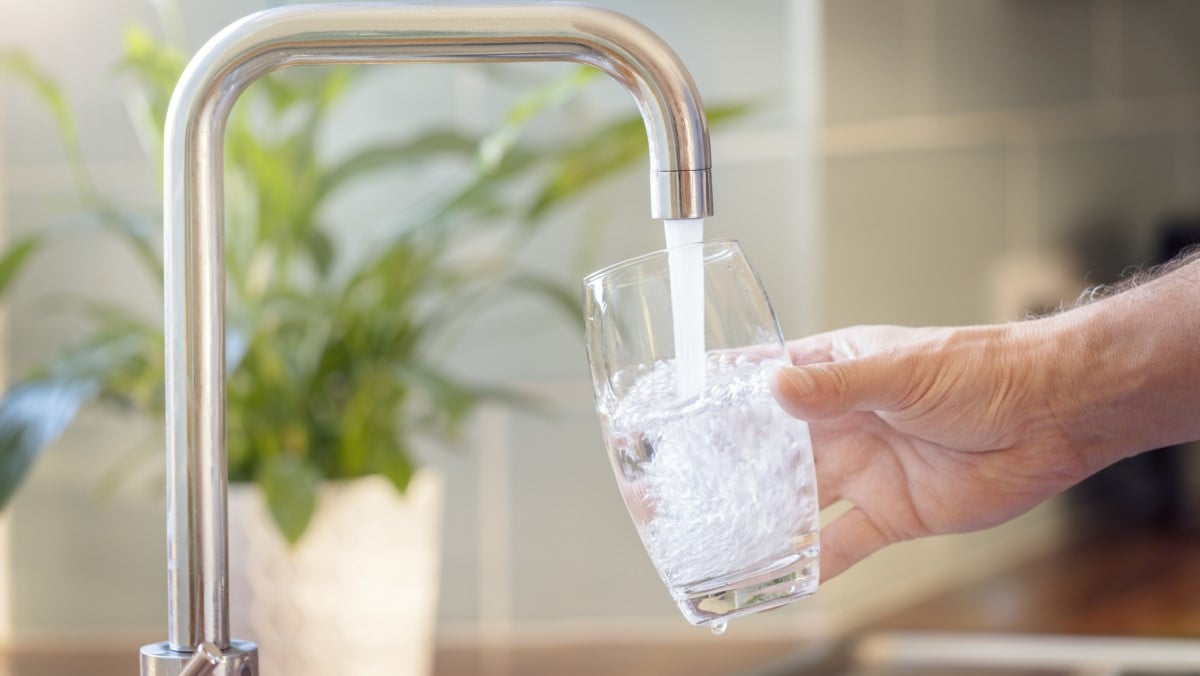Key points
- Utilities add disinfectants, such as chlorine or chloramine, to tap water to kill germs and make it safe to drink.
- Low levels of disinfectants kill germs as water travels through pipes to your tap.
- The low levels of disinfectants allowed in tap water do not make people sick.

Overview
The source of your tap water, such as a reservoir or well, can have germs in it. Germs can also get into water as it travels through miles of pipes to get to your tap.
To kill these germs and prevent people from getting sick, water utilities add a disinfectant to tap water. Usually, they use either chlorine or chloramine. Less commonly, utilities use other disinfectants, such as chlorine dioxide.
Some utilities switch back and forth between chlorine and chloramine at different times of the year or for other operational reasons.
Some utilities that use water from under the ground do not add a disinfectant. This is because testing shows the water does not have enough germs in it to make people sick.
More than 100 years of water disinfection
In the United States, utilities first used chlorine to kill germs in tap water in 1908. Utilities first used chloramine in 1929.
Terms to know
Chlorine is a disinfectant that kills germs in water.
Chloramines are a group of chemical compounds that contain chlorine and ammonia. The type of chloramine used to kill germs in drinking water is called monochloramine.
Disinfection byproducts are chemicals made when chlorine or chloramine come into contact with dirt or other materials in water. At high enough levels, disinfection byproducts can cause health problems over time.
How it works
To prevent illnesses, utilities must meet water quality standards. These standards include rules about the levels of germs, disinfectants, and disinfection byproducts that can be in public tap water. Following these rules, utilities add low levels of chlorine or chloramine to kill germs during water treatment.
Safe levels of chlorine and chloramine
Chlorine or chloramine levels up to 4 milligrams per liter (mg/L), or 4 parts per million (ppm), are considered safe in drinking water. These low levels kill harmful germs and are unlikely to make people sick.
Why utilities switch disinfectants
Both chlorine and chloramine are good at killing germs in water. However, each has certain benefits and drawbacks, so utilities sometimes switch between them.
Switching to chlorine
Water pipes can grow a slimy layer of germs (called a biofilm). This layer helps protect the germs from being killed by disinfectants. Utilities may temporarily switch from chloramine to chlorine disinfection to help remove this slime layer.
Switching to chloramine
Chlorine gets used up quickly in water. Sometimes there is not enough chlorine left to keep killing germs by the time the water reaches your tap. Utilities may switch to chloramine because it can keep killing germs in water pipes longer than chlorine.
Chloramine also makes fewer disinfection byproducts than chlorine.
Impacts
Taste and smell
Water containing chlorine can taste and smell different than untreated water or water containing chloramine. Water may have more taste or smell problems when it has higher levels of chlorine or more dirt and other particles in it.
Lead and copper levels
Chloramine can change the chemical properties of the water, which can affect lead and copper pipes. The U.S. Environmental Protection Agency (EPA) strictly regulates lead and copper levels in drinking water. EPA provides guidance for water utilities switching to chloramine on how to minimize lead and copper levels.
If you are concerned about lead or copper levels in your water, call EPA's Safe Drinking Water Hotline at 800-426-4791. They can provide information about testing.
Health risks
Water utilities regularly check water quality to provide you with safe drinking water. However, some people are more sensitive than others to chemicals.
Talk to a healthcare provider if you have concerns about your tap water affecting your health.
Dialysis
Dialysis requires the use of large amounts of water to clean waste products out of a patient's blood. Dialysis centers must treat the water to remove all chemical disinfectants, including chlorine and chloramine, before the water can be used for dialysis. If you do dialysis at home, check your machine's instructions or contact the manufacturer about how to treat water before using it.
Pets
Do not keep the following animals in water containing chlorine or chloramine:
- Fish or other animals that live in water
- Reptiles, such as turtles
- Amphibians, such as frogs
Unlike people and other pets, these types of animals absorb water directly into their blood stream. Even low levels of disinfectants can make them sick.
You can buy products at a pet store to remove chlorine or chloramine. Ask pet store staff about ways to remove disinfectants from water for these pets.
You can also remove chlorine from water by letting it sit out for a few days. You cannot remove chloramine this way, however.
The small amount of chlorine or chloramine utilities add to water will not affect other pets, such as dogs, cats, or birds. You do not need to remove disinfectants from water before washing these pets or giving them water to drink.
What you can do
If you are served by a public water system, find out about disinfectants in your water from your utility. Look at your annual water quality report to see:
- If there is disinfectant in your water
- What kind of disinfectant your utility uses
- Levels of disinfectant and disinfection byproducts in your water
- If levels were not within a safe range over the past year
